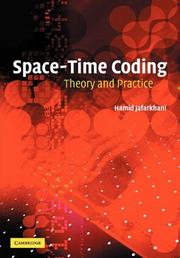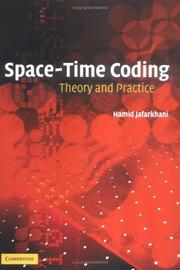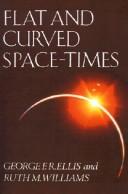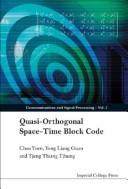| Listing 1 - 10 of 511 | << page >> |
Sort by
|

ISBN: 1107151678 0521131405 0511181957 0511115075 0511199082 128043483X 0511536771 0511299842 9786610434831 Year: 2005 Publisher: Cambridge : Cambridge University Press,
Abstract | Keywords | Export | Availability | Bookmark
 Loading...
Loading...Choose an application
- Reference Manager
- EndNote
- RefWorks (Direct export to RefWorks)
This book covers the fundamental principles of space-time coding for wireless communications over multiple-input multiple-output (MIMO) channels, and sets out practical coding methods for achieving the performance improvements predicted by the theory. Starting with background material on wireless communications and the capacity of MIMO channels, the book then reviews design criteria for space-time codes. A detailed treatment of the theory behind space-time block codes then leads on to an in-depth discussion of space-time trellis codes. The book continues with discussion of differential space-time modulation, BLAST and some other space-time processing methods and the final chapter addresses additional topics in space-time coding. The theory and practice sections can be used independently of each other. Written by one of the inventors of space-time block coding, this book is ideal for a graduate student familiar with the basics of digital communications, and for engineers implementing the theory in real systems.
Book
Year: 2021 Publisher: Istanbul, Turkiye Istanbul University Press
Abstract | Keywords | Export | Availability | Bookmark
 Loading...
Loading...Choose an application
- Reference Manager
- EndNote
- RefWorks (Direct export to RefWorks)
Surrounding all along the sky during nighttime and known as the “Milky Way” with its name coming from the mythology, the hazy structure is a part of our Galaxy that contains billions of stars. The Milky Way Galaxy, which we are the inhabitants of, is a system that contains much more than this hazy structure. Since the Milky Way’s first observation with a telescope by Galileo in 1610, we are still trying to understand the structure, formation and evolution of our Galaxy, with the help of earth and space-based telescopes.In the study of the Milky Way as a galaxy, both extragalactic astronomy and stellar populations are utilized by using photometric, astrometric and spectral methods. Until the 21st century, traditional star counting analysis was used to understand the stellar populations and the basic structure of our Galaxy. Since the 21st century, with high resolution, sensitive, large scale and systematic CCD based sky surveys have come into play. Sent to space in 2013, the satellite Gaia has become one of the corner stones of Galactic astronomy and started the golden age of astrometry. With this satellite, it is aimed to observe over a billion of objects in our Galaxy. Thus, in the 21st century, the observational data accumulation, diversified with unprecedentedly sensitive astrometric, spectral and photometric data, and reached large dimensions, has given the opportunity to examine our Galaxy not only structurally but also in terms of its formation and evolution, and opened new horizons for the testing of chemo-dynamic evolutionary scenarios.Researches also focused on various topics of astronomy has been accomplished in Turkey for decades. As these studies are presented in international publications, they also found places in national congresses and workshops. Still, studies contributing to Galactic astronomy are carried out by examining sky survey data, star clusters, binary stars and similar objects, and observational initiatives and calibration projects to support these studies are carried out simultaneously. Moreover, these studies show remarkable developments in qualitative and quantitative terms.The aim of the meeting that took place on September 12-13 2019, titled “Galactic Astronomy Workshop” with international participants was to discuss the researches contributing directly or indirectly to Galactic astronomy starting from the observations of different objects, meeting the researchers to discuss this specific issue, establishing collaborations that can lead to joint studies and to foresee of these said studies in our country. Gece gökyüzümüzü boydan boya kuşatan ve mitolojiden gelen ismiyle “Milky Way (Samanyolu)” olarak bilinen puslu yapı milyarlarca yıldız içeren Galaksimizin bir parçasıdır. İçinde bulunduğumuz Samanyolu Galaksisi bu puslu yapıdan çok daha fazlasını içeren bir sistemdir. 1610 yılında Samanyolu’nu bir teleskop ile ilk kez inceleyen Galileo’dan bu yana, yer ve uzay tabanlı teleskoplar yardımıyla Galaksimizin yapısını, oluşumunu ve evrimini hala öğrenmeye çalışıyoruz.Bir galaksi olarak Samanyolu’nun incelenmesinde fotometrik, astrometrik ve tayfsal yöntemleri kullanarak hem galaksi-dışı astronomiden hem de yıldız popülasyonlarından yararlanılır. 21. yüzyıla kadar geleneksel yıldız sayımları analizi, Galaksimizin temel yapısının ve yıldız popülasyonlarının anlaşılmasını sağlarken, bu yüzyıldan itibaren CCD tabanlı, yüksek ayırma güçlü, duyarlı, büyük ölçekte ve sistematik sayısal gökyüzü taramaları devreye girmiştir. 2013 yılında uzaya gönderilen, Galaktik astronomi için köşe taşlarından biri olan ve astrometrinin altın çağını açan Gaia uydusu ile de Galaksimizdeki bir milyardan fazla nesnenin gözlenmesi hedeflenmiştir. Böylece, 21. yüzyılda şimdiye kadar görülmemiş derecede duyarlı astrometrik, tayfsal ve fotometrik verilerle çeşitlenen ve büyük boyutlara ulaşan gözlemsel veri birikimi, Galaksimizin sadece yapısal olarak değil, oluşumu ve evrimi açısından da incelenmesine fırsat vermiş ve kemo-dinamik evrim senaryolarının sınanması için yeni ufuklar açmıştır.Astronominin çeşitli konularına odaklanmış araştırmalar Türkiye’de de on yıllardır yapılagelmiştir. Bu çalışmalar uluslararası yayınlarda sunulduğu gibi, ulusal kongreler ve çalıştaylarda da tartışma ortamları bulmuştur. Halen gökyüzü tarama verilerinin, yıldız kümelerinin, çift yıldızlar ve benzeri nesnelerin incelenmesiyle Galaktik astronomiye katkıda bulunacak araştırmalar yapılmakta ve bu çalışmaları destekleyecek gözlemsel girişimler ve kalibrasyon projeleri de eş zamanlı olarak yürütülmektedir. Üstelik bu çalışmalar nitel ve nicel yönden dikkat çekici gelişmeler göstermektedir.12-13 Eylül 2019 tarihlerindeki “Galaktik Astronomi Çalıştayı” başlıklı uluslararası katılımlı bu toplantı, farklı nesnelerin gözlemlerinden itibaren Galaktik astronomiye doğrudan ya da dolaylı katkıda bulunan araştırmaları ele almak, araştırmacıların buluşarak bu özgül konuda tartışmalarını sağlamak, ortak çalışmalara yol açabilecek işbirlikleri oluşturmak ve ülkemizdeki geleceğini öngörmek amacıyla düzenlenmiştir.
Book
Year: 1993 Publisher: Cambridge : Cambridge University Press,
Abstract | Keywords | Export | Availability | Bookmark
 Loading...
Loading...Choose an application
- Reference Manager
- EndNote
- RefWorks (Direct export to RefWorks)
Book
Year: 2021 Publisher: Istanbul, Turkiye Istanbul University Press
Abstract | Keywords | Export | Availability | Bookmark
 Loading...
Loading...Choose an application
- Reference Manager
- EndNote
- RefWorks (Direct export to RefWorks)
Surrounding all along the sky during nighttime and known as the “Milky Way” with its name coming from the mythology, the hazy structure is a part of our Galaxy that contains billions of stars. The Milky Way Galaxy, which we are the inhabitants of, is a system that contains much more than this hazy structure. Since the Milky Way’s first observation with a telescope by Galileo in 1610, we are still trying to understand the structure, formation and evolution of our Galaxy, with the help of earth and space-based telescopes.In the study of the Milky Way as a galaxy, both extragalactic astronomy and stellar populations are utilized by using photometric, astrometric and spectral methods. Until the 21st century, traditional star counting analysis was used to understand the stellar populations and the basic structure of our Galaxy. Since the 21st century, with high resolution, sensitive, large scale and systematic CCD based sky surveys have come into play. Sent to space in 2013, the satellite Gaia has become one of the corner stones of Galactic astronomy and started the golden age of astrometry. With this satellite, it is aimed to observe over a billion of objects in our Galaxy. Thus, in the 21st century, the observational data accumulation, diversified with unprecedentedly sensitive astrometric, spectral and photometric data, and reached large dimensions, has given the opportunity to examine our Galaxy not only structurally but also in terms of its formation and evolution, and opened new horizons for the testing of chemo-dynamic evolutionary scenarios.Researches also focused on various topics of astronomy has been accomplished in Turkey for decades. As these studies are presented in international publications, they also found places in national congresses and workshops. Still, studies contributing to Galactic astronomy are carried out by examining sky survey data, star clusters, binary stars and similar objects, and observational initiatives and calibration projects to support these studies are carried out simultaneously. Moreover, these studies show remarkable developments in qualitative and quantitative terms.The aim of the meeting that took place on September 12-13 2019, titled “Galactic Astronomy Workshop” with international participants was to discuss the researches contributing directly or indirectly to Galactic astronomy starting from the observations of different objects, meeting the researchers to discuss this specific issue, establishing collaborations that can lead to joint studies and to foresee of these said studies in our country. Gece gökyüzümüzü boydan boya kuşatan ve mitolojiden gelen ismiyle “Milky Way (Samanyolu)” olarak bilinen puslu yapı milyarlarca yıldız içeren Galaksimizin bir parçasıdır. İçinde bulunduğumuz Samanyolu Galaksisi bu puslu yapıdan çok daha fazlasını içeren bir sistemdir. 1610 yılında Samanyolu’nu bir teleskop ile ilk kez inceleyen Galileo’dan bu yana, yer ve uzay tabanlı teleskoplar yardımıyla Galaksimizin yapısını, oluşumunu ve evrimini hala öğrenmeye çalışıyoruz.Bir galaksi olarak Samanyolu’nun incelenmesinde fotometrik, astrometrik ve tayfsal yöntemleri kullanarak hem galaksi-dışı astronomiden hem de yıldız popülasyonlarından yararlanılır. 21. yüzyıla kadar geleneksel yıldız sayımları analizi, Galaksimizin temel yapısının ve yıldız popülasyonlarının anlaşılmasını sağlarken, bu yüzyıldan itibaren CCD tabanlı, yüksek ayırma güçlü, duyarlı, büyük ölçekte ve sistematik sayısal gökyüzü taramaları devreye girmiştir. 2013 yılında uzaya gönderilen, Galaktik astronomi için köşe taşlarından biri olan ve astrometrinin altın çağını açan Gaia uydusu ile de Galaksimizdeki bir milyardan fazla nesnenin gözlenmesi hedeflenmiştir. Böylece, 21. yüzyılda şimdiye kadar görülmemiş derecede duyarlı astrometrik, tayfsal ve fotometrik verilerle çeşitlenen ve büyük boyutlara ulaşan gözlemsel veri birikimi, Galaksimizin sadece yapısal olarak değil, oluşumu ve evrimi açısından da incelenmesine fırsat vermiş ve kemo-dinamik evrim senaryolarının sınanması için yeni ufuklar açmıştır.Astronominin çeşitli konularına odaklanmış araştırmalar Türkiye’de de on yıllardır yapılagelmiştir. Bu çalışmalar uluslararası yayınlarda sunulduğu gibi, ulusal kongreler ve çalıştaylarda da tartışma ortamları bulmuştur. Halen gökyüzü tarama verilerinin, yıldız kümelerinin, çift yıldızlar ve benzeri nesnelerin incelenmesiyle Galaktik astronomiye katkıda bulunacak araştırmalar yapılmakta ve bu çalışmaları destekleyecek gözlemsel girişimler ve kalibrasyon projeleri de eş zamanlı olarak yürütülmektedir. Üstelik bu çalışmalar nitel ve nicel yönden dikkat çekici gelişmeler göstermektedir.12-13 Eylül 2019 tarihlerindeki “Galaktik Astronomi Çalıştayı” başlıklı uluslararası katılımlı bu toplantı, farklı nesnelerin gözlemlerinden itibaren Galaktik astronomiye doğrudan ya da dolaylı katkıda bulunan araştırmaları ele almak, araştırmacıların buluşarak bu özgül konuda tartışmalarını sağlamak, ortak çalışmalara yol açabilecek işbirlikleri oluşturmak ve ülkemizdeki geleceğini öngörmek amacıyla düzenlenmiştir.

ISBN: 0521842913 Year: 2005 Publisher: Cambridge Cambridge university press
Abstract | Keywords | Export | Availability | Bookmark
 Loading...
Loading...Choose an application
- Reference Manager
- EndNote
- RefWorks (Direct export to RefWorks)
Book
ISBN: 1282259350 9786612259357 0470443634 0470443626 9780471209218 047120921X 9780470443637 Year: 2009 Publisher: Hoboken, New Jersey Wiley :
Abstract | Keywords | Export | Availability | Bookmark
 Loading...
Loading...Choose an application
- Reference Manager
- EndNote
- RefWorks (Direct export to RefWorks)
Discover cutting-edge research in wireless communications This book presents cutting-edge research in wireless communications, particularly in the fast-growing subject of multiple-input multiple-output (MIMO) wireless communication systems. It begins with an introduction, which includes historical notes and a review of turbo-information processing and MIMO wireless communications, and goes on to cover: . MIMO channel capacity. BLAST architectures. Space-time turbo codes and turbo decoding principles. Turbo-BLAST. Turbo-MIMO systems The material is complemented with abundant illustrations and computer experiments that are designed to help readers reinforce their understanding of the underlying subject matter. Space-Time Layered Information Processing for Wireless Communications is an ideal resource for researchers in academia and industry and an excellent textbook for related courses at the graduate level.
Book
Year: 1967 Publisher: Ann Arbor : University Microfilms,
Abstract | Keywords | Export | Availability | Bookmark
 Loading...
Loading...Choose an application
- Reference Manager
- EndNote
- RefWorks (Direct export to RefWorks)
Book
Year: 1993 Publisher: Oxford : Clarendon Press,
Abstract | Keywords | Export | Availability | Bookmark
 Loading...
Loading...Choose an application
- Reference Manager
- EndNote
- RefWorks (Direct export to RefWorks)
GRAVITATION --- COSMOLOGY --- SPACE-TIME MODEL

ISBN: 0198511698 Year: 1988 Publisher: Oxford : Clarendon Press,
Abstract | Keywords | Export | Availability | Bookmark
 Loading...
Loading...Choose an application
- Reference Manager
- EndNote
- RefWorks (Direct export to RefWorks)

ISBN: 1281867640 9786611867645 1860948693 9781860948695 9781281867643 1860948685 9781860948688 Year: 2007 Publisher: London Imperial College Press Hackensack, NJ Distributed by World Scientific
Abstract | Keywords | Export | Availability | Bookmark
 Loading...
Loading...Choose an application
- Reference Manager
- EndNote
- RefWorks (Direct export to RefWorks)
Quasi-Orthogonal Space-Time Block Code presents an up-to-date, comprehensive and in-depth discussion of an important emerging class of space-time codes, called the Quasi-Orthogonal STBC (QO-STBC). Used in Multiple-Input Multiple-Output (MIMO) communication systems, they provide transmit diversity with higher code rates than the well-known orthogonal STBC (O-STBC), yet at lower decoding complexity than non-orthogonal STBC. This book will help readers gain a broad understanding of the fundamental principles as well as the state-of-the-art work in QO-STBC, thus enabling them to appreciate
| Listing 1 - 10 of 511 | << page >> |
Sort by
|

 Search
Search Feedback
Feedback About
About Help
Help News
News